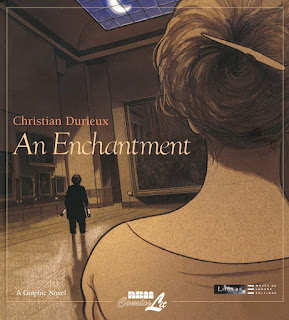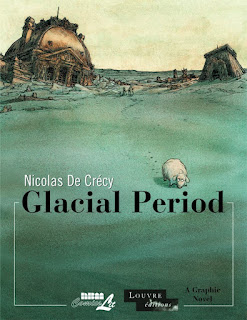Proxy Mom: My Experience with Portpartum Depression by Sophie Adriansen & Mathou
Babies are hard. I think everyone knows that intellectually, but maybe not emotionally. My own first child was a needy, demanding, unhappy baby – I don’t want to claim too much; this was a quarter-century ago, and I wasn’t the main caregiver, either – so I have some insight but nothing like expertise.
The mother in Proxy Mom: My Experience with Postpartum Depression has a fairly typical, average baby: no more needy than most, no specific problems, nothing out of the ordinary. Just crying every hour or few hours, all day every day, needing something that’s often not clear. Just an ordinarily demanding, life-altering baby, on top of everything the pregnancy and birth already did to her body.
This graphic novel is loosely a memoir – writer Sophie Adriansen and artist Mathou both lived through versions of this story, the same year, each having a first baby with a man who already had older children. And, from the story, I guess they both had problems attaching, with feeling “motherly,” at least at first – that’s a lot more common than people realize.
A baby is a wrinkled, red-faced, crying lump, capable only of wanting things. That’s not inherently lovable. It takes a lot of hormones hitting just the right way to forge that connection, and sometimes it takes quite a while – sometimes it fizzles at first.
Sometimes, like with Marietta in this story, it’s more overwhelming and painful than wonderful and special. And the realization that life is not going to be “like before, but with a baby” but instead “completely different, in ways you didn’t expect” is frightening and unnerving: there’s now this tiny person that is utterly dependent on you for everything, needy in a way no other human being has been for you before.
This is the story of about those first six months, the toughest time, for Marietta and her husband Chuck and baby Zoe. How she was overwhelmed by the pain at first, in the hospital, after a tough labor and pain during breastfeeding. How Chuck was the experienced one – but not the one whose body was battered by the birth, and not the one there all day every day with tiny needy Zoe. How she wanted that deep connection with her baby, but it wasn’t there at first – how she found it, how she got there in the end.
There are no huge problems. This is not the kind of memoir subtitled “how I got through This Horrible Thing and it made me a better person.” Birth is natural. Babies are natural. Crying babies and post-partum pain and being overwhelmed are entirely natural. It’s huge for the woman going through it. It feels too big too handle: being responsible, every second of every day, for another person, a person who can do nothing at all for herself.
But Marietta made it through. She didn’t get back “her old life, but with a baby” – she got back a new life, with a lot of the pieces of the old one, plus a baby, transforming everything else as a baby always does. Adriansen and Mathou have lived this, and they tell that story naturalistically and realistically, always through Marietta’s viewpoint, always focused on how she feels about herself and her baby.
They tell that story in a lovely, immediate way through cartooning. Mathou’s style is warm and inviting, big eyes and rounded bodies and slightly exaggerated expressions. Adriansen keeps the captions short and focused – this is the kind of book that could have a blizzard of expert opinions footnoted on every page, but she smartly knows they’re not needed. Marietta’s situation is natural: millions of women go through it every year, and need support and love and attention to get through it.
This US edition was translated and Americanized by Montana Kane from the original French, including, I assume, some facts and figures Adriansen includes along the way. I noticed the numbers were about the USA, but nothing else about the translation, which is the best reaction to a translation: if you don’t notice it, it’s done right.
This is the kind of book that says “you’re not alone” to a huge number of women struggling with what is usually the biggest, hardest, most exhaustingly wonderful thing that they’ve ever had to deal with. It says that clearly, lovingly, from the point of view of another woman who has been through it.
Reposted from The Antick Musings of G.B.H. Hornswoggler, Gent.





















